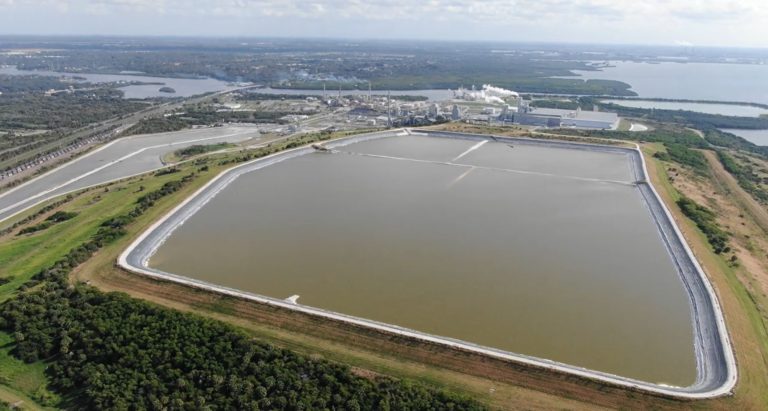EPA Petitioned to Protect Communities, Environment From Radioactive Phosphogypsum Stacks, Wastewater
By: Waterkeeper Alliance

Conservation and public-health groups petitioned the Environmental Protection Agency today to improve federal oversight of the radioactive waste produced by phosphogypsum facilities, including wastewater from phosphoric acid production.
Phosphogypsum and process wastewater from phosphogypsum facilities are currently excluded from certain federal hazardous waste regulations.
Today’s petition asks the EPA to begin overseeing the safe treatment, storage, and disposal of phosphogypsum and process wastewater, as required under the Resource Conservation and Recovery Act and Toxic Substances Control Act.
“Many people are living near vulnerable mountains of radioactive, toxic waste known as gypsum stacks without even knowing what they are, let alone the risks to environmental and public health they present,” said Brooks Armstrong, of People for Protecting Peace River. “People living near phosphogypsum stacks, downstream communities, the wider public and wildlife depend on a drinking water supply which flows under these stacks. We deserve maximum protection from these gypsum stacks by our EPA. As of now, we are getting virtually none.”
Phosphogypsum is the radioactive waste from processing phosphate ore into phosphoric acid, which is predominantly used in fertilizer. Radium-226, found in phosphogypsum, has a 1,600-year radioactive decay half-life. In addition to high concentrations of radioactive materials, phosphogypsum and process wastewater can also contain carcinogens and heavy toxic metals like antimony, arsenic, barium, cadmium, chromium, copper, fluoride, lead, mercury, nickel, silver, sulfur, thallium, and zinc.
“These towering stacks of radioactive waste continue to pose an unacceptable risk to the environment and nearby communities,” said Jaclyn Lopez, Florida director at the Center for Biological Diversity. “They’re prone to massive sinkholes and spills that put our groundwater and recreational waters at risk and threaten public health. The EPA must face the facts and act quickly to avert the next environmental disaster.”
For every ton of phosphoric acid produced, the fertilizer industry creates five tons of radioactive phosphogypsum waste, which is stored in mountainous stacks hundreds of acres wide and hundreds of feet tall. More than 1 billion tons of the radioactive waste have already been stored in 25 stacks scattered throughout Florida. The stacks are perched precariously atop the Floridan aquifer, which supplies drinking water to 10 million people.
“EPA knows from decades of mining disasters that storing radioactive and carcinogenic mining waste in enormous open-air piles over groundwater aquifers poses an imminent danger to human health and the environment,” said Daniel E. Estrin, general counsel and advocacy director for Waterkeeper Alliance. “These dangerous ‘gypstack’ eyesores are often hundreds of feet high and cover hundreds of acres of land. We are counting on EPA to do its job and protect people and wildlife from this ticking time bomb before the next foreseeable disaster.”
The phosphogypsum stacks are also in Arkansas, Idaho, Illinois, Iowa, Louisiana, Mississippi, Missouri, North Carolina, Texas, Utah, and Wyoming. The EPA recently approved using this radioactive waste in road construction.
“Phosphogypsum has the potential to sicken Floridians. To continue down this path for the benefit of fertilizer industry is cruel and misguided,” said Michael Roth, president of Our Santa Fe River.
“WWALS opposes expansion of the decades-old moonscape of a phosphate mine in Hamilton County, and another proposed in Union and Bradford Counties,” said John S. Quarterman, Suwannee Riverkeeper. “These mines not only suck up massive amounts of water that reduce spring and river flows, they feed ever-growing phosphogypsum stacks with radioactive waste.”
Today’s petition was filed by Atchafalaya Basinkeeper, Bayou City Waterkeeper, Center for Biological Diversity, The Cherokee Concerned Citizens, Healthy Gulf, ManaSota-88, Our Santa Fe River, People for Protecting Peace River, RISE St. James, Sierra Club’s Florida and Delta chapters, Waterkeeper Alliance, and Waterkeepers Florida, which includes all 14 of Florida’s Waterkeeper groups.
The petition asks the EPA, under the Resource Conservation and Recovery Act and Toxic Substances Control Act, to:
- Reverse its 1991 regulatory determination that excludes phosphogypsum and process wastewater from hazardous waste regulations;
- Govern the safe treatment, storage and disposal of phosphogypsum and process wastewater as hazardous wastes;
- Initiate the process for designating phosphogypsum and process wastewater as high-priority substances for risk evaluation;
- Require manufacturers to conduct testing on phosphogypsum and process wastewater; and
- Determine that the use of phosphogypsum in road construction is a significant new use that requires a determination on whether it is safe.
Learn more about phosphogypsum and efforts to protect the public health and environment from its harms.